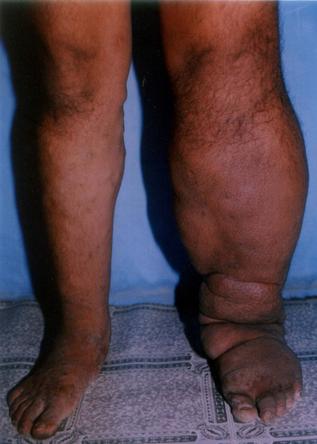Also known as Elephantiasis
ABOUT THE DISEASE
Lymphatic filariasis (LF), is a disease caused by mosquito bites leading to infection with the filarial worms, Wucheria bancrofti, Burgia malayi or B.timori. The worms develop into adult worms in the lymphatic vessels, causing severe damage and swelling (lymphodema). In the early stages of this severely disfiguring, disabling disease, there are no symptoms, but the lymphatic system is damaged. This stage can last for several years. Infected persons sustain the transmission of the disease.
The long term physical consequences are painful, swollen limbs (lymphoedema or elephantiasis) and genital organs. Hydrocele in males is also commonly observed.

SYMPTOMS
There might be no symptoms visible initially.
In later stage, some of the following symptoms are visible:
- • Swelling in the arms, breast or legs
- • For males - swelling in the genital area and / or Hydrocele
- • Swelling and the decreased function of the lymph system make it difficult for the body to fight germs and infections, leading to frequent bacterial infections in the skin and lymph system. This causes hardening and thickening of the skin – elephantiasis.
CAUSES
Lymphatic filariasis affects over 120 million people in 73 countries throughout the tropics and sub-tropics of Asia, Africa, the Western Pacific, and parts of the Caribbean and South America.
Lymphatic filariasis is transmitted through mosquito bites. The microfilariae enter the body of a mosquito, when it feeds on the blood of a person carrying microfilariae in their blood (mf carriers). It takes 7-21 days for the microfilariae to develop inside the body of the mosquito.
Many types of mosquitoes can transmit the parasite, depending on the geographic area. In Africa, the most common vector is Anopheles and in the Americas, it is Culex quinquefasciatus. Aedes and Mansonia can transmit the infection in the Pacific and in Asia. Many mosquito bites over several months to years are needed to get lymphatic filariasis. People living for a long time in tropical or sub-tropical areas where the disease is common are at the greatest risk for infection. Short-term tourists have a very low risk.
The adult produces millions of very small, immature larvae known as microfilariae, which circulate in the peripheral blood with marked nocturnal periodicity. The worms usually live and produce microfilariae for 4-6 years.
DIAGNOSIS
- Identification of microfilariae in a blood smear by microscopic examination. They circulate in the blood at night (called nocturnal periodicity). Therefore, blood collection should be done at night to coincide with the appearance of the microfilariae.
- Immunological tests such as Serum IgE and IgG4 are elevated with active disease.
- Ultrasound- reveals obstruction of the inguinal and scrotal lymphatics
TREATMENT METHODS
There is no cure for this disease in the chronic stage, however, people infected with adult worms can take a yearly dose of medicine Diethylcarbamazine (DEC) that kills the circulating microfilariae in the blood and long acting Penicillin injection. While this does not kill all the adult worms, it does prevent infected people from giving the disease to someone else. Even after the adult worms die, lymphoedema can develop. To prevent lymphoedema from getting worse, following basic principles may help:
- Carefully wash the swollen area with soap and water every day.
- Use anti-bacterial cream on any wound. This stops bacterial infections.
- Elevate and exercise the swollen arm or leg to move the fluid and improve the lymph flow.
Sometimes it may require other measures, eg. surgery for hydrocele, and exercise to increase lymphatic drainage in lymphoedema.
Surgery for Filariasis to reduce gross limb elephantiasis may be tried in few cases.
Government runs programs to eradicate this disease from endemic areas, for which DEC medicine needs to be administered to the complete population of that area or village as per the age.
You may also like to learn about:
Cellulitis
Lymphedema
Swelling
Malaria
Lymphadenopathy
Hydrocele